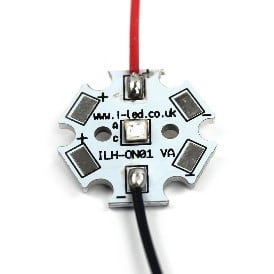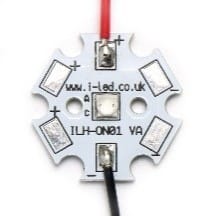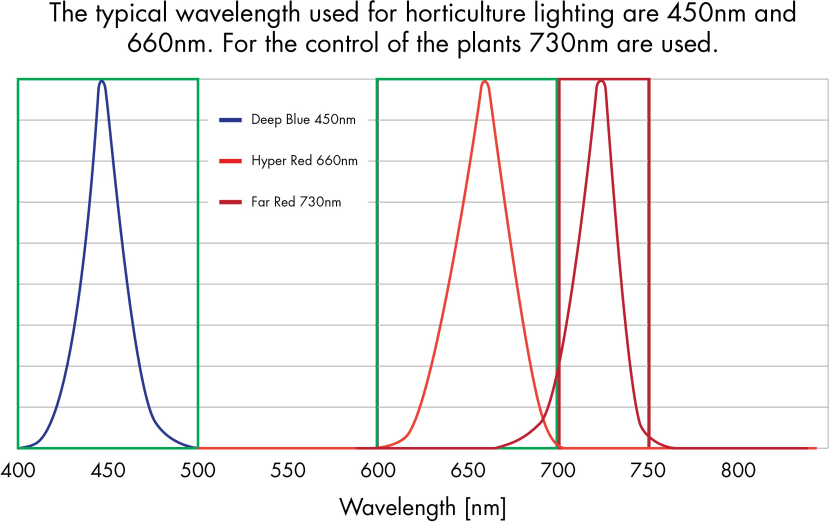The uses of colour LEDs in horticultural lighting
Follow articleHow do you feel about this article? Help us to provide better content for you.
Thank you! Your feedback has been received.
There was a problem submitting your feedback, please try again later.
What do you think of this article?
Horticulture is being revolutionised by advancements in LED lighting. New technologies enabled by an ever-expanding knowledge base are demonstrating how plants require different spectral illumination and control. Intelligent Horticultural Solutions (IHS) was formed to help support the development and manufacture of products in the fast-moving, exciting area of horticultural LED lighting.
So, how do different LED wavelengths (colours) affect plant and crop growth? We know that water, nutrients, temperature and many other factors all play a key role but light is also an important contributor. This article is part of a series of articles from IHS which explores the many variations of lighting. It can be used, to help unpick and simplify the expanding horticultural LED lighting market. In this article, we will explore the key colour wavelengths in horticulture, what they do and why you should use them. Other, related articles in this series include:
- White Light in Horticulture – Supplemental vs Non-Supplemental Products
- The Importance of Ultraviolet in Horticultural Lighting
- Pick Your Own Custom LED Engines
- IHS Announce PHYTOFY RL from OSRAM
Why do plants need light?
Since crop cultivation began, all fruit, vegetables, flowers and herbs have been impacted by the sun. Plant growth is naturally stimulated by the duration, spectrum and intensity of sunlight. Photon flux density (PFD), which refers to the intensity that photosynthetically active photons hit the surface area of a plant, greatly impacts a plant’s biomass and growth rate. Furthermore, the spectral power distribution, which refers to the energy levels of the light source, has been shown to have an impact in regulating the morphology and even the colour of certain genotypes of a plant. Finally, the photoperiod, which refers to the timing and duration of light, can effectively regulate the flowering times of certain short-day and long-day plants. These components of light are not exclusive, but they all work together to regulate the overall growth of plants.
Different wavelengths emitted by sunlight contribute to various aspects of plant growth. The plants absorb these useful wavelengths. The spectral composition of the different wavelength regions (blue, green, yellow, red, far red or non-visible UV or IR) is important for the growth, shape, development and flowering (photomorphogenesis) of the plant.
How do plants react to different wavelengths?
Plants do not react the same as the human eye, which reacts to light with the short, medium and long photoreceptors allowing us to see in colour. Plants respond to light with carotenoids which are pigments in the plants responsible for red yellow and orange hues in many fruits and vegetables, and with chlorophyll and phytochromes which regulate their growth. Chlorophyll absorption is linked to photosynthesis and therefore to the growth of the plant. A plant’s phytochromes are sensors which react to the environment and adjust the morphology. The absorption spectrum of the eye is primarily a combination of red, green and blue however a plant will respond differently to wavelengths within the range of 280-800nm.
So plants absorption of wavelengths from either a natural or an artificial source, directly impact upon its growth and appearance. Therefore, it is key to understand what impact different wavelengths have on plants, and why we use the LED colours that we do.
Why does horticultural lighting often appear pink?

How do plants respond to different wavelengths / colours?
Different regions of the wavelength in the illumination spectrum have different effects on the plants:
| Wavelength range (nm) | Photosynthesis | Further Effects | Further Effects | Further Effects |
|---|---|---|---|---|
| 200 - 280 | Harmful | |||
| 280 - 315 | Harmful | |||
| 315 - 380 | ||||
| 380 - 400 | Yes | |||
| 400 - 520 | Yes | Vegative Growth | ||
| 520 - 610 | Some | Vegative Growth | ||
| 610 - 720 | Yes | Vegative Growth | Flowering | Budding |
| 720 - 1000 | Germination | Leaf Building | Flowering | |
| >1000 | Converted to Heat |
Wavelengths 450nm (deep blue) and 660nm (hyper red) both provide energy for the plant. But the blue light, which is absorbed by cryptochrome within plants, is also responsible for photomorphogenic functions such as stomatal control, stem elongation, and phototropism. While a ratio of red to far‐red light is detected by phytochromes and stimulates stress responses such as elongation growth, apical dominance and flowering.
Far red 730nm LEDs can be used to influence the height of the plant. Exposing a plant to more of this colour wavelength, makes the plant feel like it is in the shadow of a bigger plant, which then triggers the “shade escape reaction” meaning that the plants growth rate is increased. This wavelength can also influence when a plant’s flowers bloom. It can make a plant’s flowers bloom in winter or even prevent them from blossoming in summer.
Although light in the green wavelength range is not easily absorbed and is generally assumed to have a lesser effect on plant growth and photosynthesis, some research has indicated that mixing 24% of green fluorescent LED light (500 to 600 nm) with red and blue LEDs (630 and 470 nm respectively) produces more biomass than other wavelength mixes. This may be because green light can penetrate lower than red or blue light in the plant canopy allowing the lower plant leaves to use the green light for photosynthesis.
Common LED colour combinations
Key colour wavelengths can be paired together to create optimum LED recipes. Different plant types require different light mixes and by identifying what these optimum LED recipes are, growing performance and plant quality can be improved upon. For example as the below table shows, a combination of blue and red wavelengths is ideal for leafy green plant types because they provide energy to the plant and prompt leafy biomass growth.
With greater understanding of the relationship between light wavelengths and the effect on growth and morphology, LEDs can also be used to control the spectral composition of light quality and quantity, thereby reducing energy usage and preventing the undesirable effects of certain regions of the light spectrum.
Horticultural lighting techniques using coloured LEDs
Coloured LEDs can be utilised in various ways in horticulture, depending on the sort of lighting application and what the end goal is. Here are just a few horticultural lighting techniques:
- Supplemental Lighting – Used to supplement pre-existing natural daylight, in order to enhance photosynthesis and thereby improve growth and quality of plants. Often used in greenhouse settings. Coloured LEDs are perfect for supplemental applications, as increasing quantities of key wavelengths the plants receive, can help give them a boost.
- Photoperiodic Lighting – Used to control the light period by extending the natural day length with artificial light. Useful to extend growth periods during winter months for example, when the hours of daylight are shortened
- Cultivation without daylight (non-supplemental) - Used to totally replace daylight with artificial light for ultimate climate control. Although for this application, white LEDs may also be required as well as colour LEDs, in order to make up for the wavelengths the plants would be missing out on due to the lack of natural sunlight.
Horticultural LED lighting for different applications
Currently, conventional sources of lighting suffer from inflexible and broad spectral compositions that might be sub‐optimal for growth. Incandescent and HPS lamps have higher emissions in the red region, resulting in excessive stem elongation, in contrast to fluorescent lamps which emit a higher proportion of light in the blue region and are hence limited to small‐scale in vitro growth. LEDs emit light in a narrow bandwidth of wavelengths and can, therefore, be used to supplement sunlight or current lighting systems used in greenhouses to enhance the spectral composition of light.
IHS offers a variety of Horticultural LED modules, using quality LED components from OSRAM Opto Semiconductors. Available in a variety of size PCBs, and colour wavelengths. Should you be planning to design and build your own horticultural lighting modules, IHS can assist.
Product Family |
Image |
Part Number |
Buy Here |
|---|---|---|---|
OSLON 1201 LED PowerStars |
 |
IHH-OM01-DEBL-SC221-WIR200. IHH-OM01-RDOR-SC221-WIR200. IHH-OM01-TRGR-SC221-WIR200. IHH-OM01-FRED-SC221-WIR200. IHH-OM01-HYRE-SC221-WIR200. |
|
OSLON Square1 LED PowerStars |
 |
IHH-OG01-HYRE-SC221-WIR200. IHH-OG01-DEBL-SC221-WIR200. |
|
OSLON 1206 Strips |
 |
IHS-OM06-FRED-SD221. IHS-OM06-HYRE-SD221. IHS-OM06-RDOR-SD221. IHS-OM06-DEBL-SD221. IHS-OM06-TRGR-SD221. |
|
OSLON Square6 Strips |
 |
IHS-OG06-DEBL-SD221. IHS-OG06-HYRE-SD221. |
IHS also offers LED modules (150-1899) designed with specific LED recipes for different applications, including seeding, fruiting, flowering and biomass. Also available through RS Components on 12, 16 and 33 LED modules. Furthermore we offer Florence Grow Light modules with these recipes also.
IHS is a LED Light for You (LLFY) Partner, which draws on world-leading quality LEDs from OSRAM Opto Semiconductors and combines them with other quality components, materials and in-house expertise to provide the LED solution you need.
For any enquiries or further information, please contact +44 (0) 1635 294606 or info@i-hled.co.uk or alternatively refer to our website www.i-hled.co.uk






